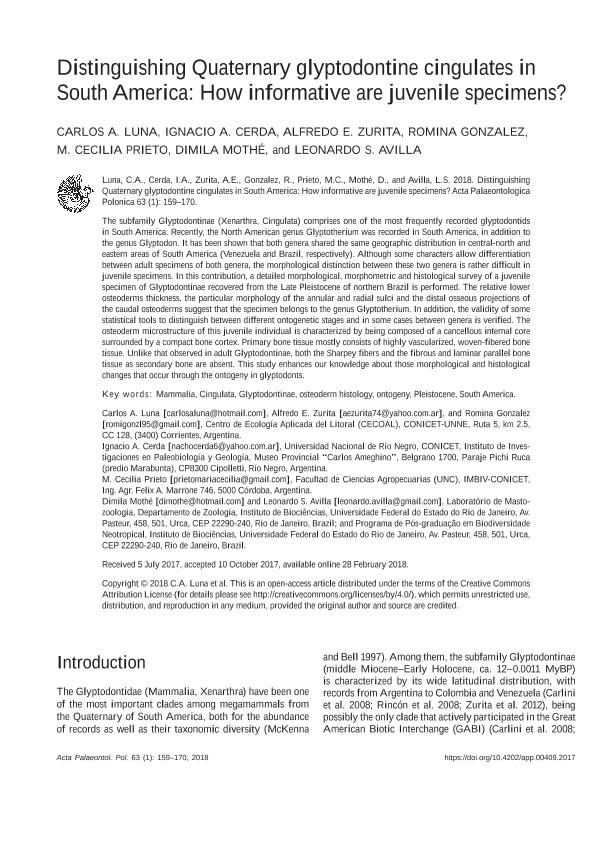Mostrar el registro sencillo del ítem
dc.contributor.author
Luna, Carlos
dc.contributor.author
Cerda, Ignacio Alejandro

dc.contributor.author
Zurita, Alfredo Eduardo

dc.contributor.author
González, Romina

dc.contributor.author
Prieto, María Cecilia

dc.contributor.author
Mothé, Dimila
dc.contributor.author
Avilla, Leonardo
dc.date.available
2019-12-19T21:09:53Z
dc.date.issued
2018-03
dc.identifier.citation
Luna, Carlos; Cerda, Ignacio Alejandro; Zurita, Alfredo Eduardo; González, Romina; Prieto, María Cecilia; et al.; Distinguishing Quaternary glyptodontine cingulates in South America: How informative are juvenile specimens?; Polish Academy of Sciences. Institute of Paleobiology; Acta Palaeontologica Polonica; 63; 1; 3-2018; 159-170
dc.identifier.issn
0567-7920
dc.identifier.uri
http://hdl.handle.net/11336/92591
dc.description.abstract
The subfamily Glyptodontinae (Xenarthra, Cingulata) comprises one of the most frequently recorded glyptodontids in South America. Recently, the North American genus Glyptotherium was recorded in South America, in addition to the genus Glyptodon. It has been shown that both genera shared the same geographic distribution in central-north and eastern areas of South America (Venezuela and Brazil, respectively). Although some characters allow differentiation between adult specimens of both genera, the morphological distinction between these two genera is rather difficult in juvenile specimens. In this contribution, a detailed morphological, morphometric and histological survey of a juvenile specimen of Glyptodontinae recovered from the Late Pleistocene of northern Brazil is performed. The relative lower osteoderms thickness, the particular morphology of the annular and radial sulci and the distal osseous projections of the caudal osteoderms suggest that the specimen belongs to the genus Glyptotherium. In addition, the validity of some statistical tools to distinguish between different ontogenetic stages and in some cases between genera is verified. The osteoderm microstructure of this juvenile individual is characterized by being composed of a cancellous internal coresurrounded by a compact bone cortex. Primary bone tissue mostly consists of highly vascularized, woven-fibered bone tissue. Unlike that observed in adult Glyptodontinae, both the Sharpey fibers and the fibrous and laminar parallel bone tissue as secondary bone are absent. This study enhances our knowledge about those morphological and histological changes that occur through the ontogeny in glyptodonts.
dc.format
application/pdf
dc.language.iso
eng
dc.publisher
Polish Academy of Sciences. Institute of Paleobiology

dc.rights
info:eu-repo/semantics/openAccess
dc.rights.uri
https://creativecommons.org/licenses/by-nc-sa/2.5/ar/
dc.subject
MAMMALIA
dc.subject
CINGULATA
dc.subject
OSTEODERM HISTOLOGY
dc.subject
SOUTH AMERICA
dc.subject.classification
Paleontología

dc.subject.classification
Ciencias de la Tierra y relacionadas con el Medio Ambiente

dc.subject.classification
CIENCIAS NATURALES Y EXACTAS

dc.title
Distinguishing Quaternary glyptodontine cingulates in South America: How informative are juvenile specimens?
dc.type
info:eu-repo/semantics/article
dc.type
info:ar-repo/semantics/artículo
dc.type
info:eu-repo/semantics/publishedVersion
dc.date.updated
2019-10-18T18:08:11Z
dc.identifier.eissn
1732-2421
dc.journal.volume
63
dc.journal.number
1
dc.journal.pagination
159-170
dc.journal.pais
Polonia

dc.journal.ciudad
Varsovia
dc.description.fil
Fil: Luna, Carlos. Consejo Nacional de Investigaciones Científicas y Técnicas. Centro Científico Tecnológico Conicet - Nordeste. Centro de Ecología Aplicada del Litoral. Universidad Nacional del Nordeste. Centro de Ecología Aplicada del Litoral; Argentina
dc.description.fil
Fil: Cerda, Ignacio Alejandro. Consejo Nacional de Investigaciones Científicas y Técnicas; Argentina. Universidad Nacional de Río Negro. Sede Alto Valle. Instituto de Investigaciones en Paleobiología y Geología; Argentina
dc.description.fil
Fil: Zurita, Alfredo Eduardo. Consejo Nacional de Investigaciones Científicas y Técnicas. Centro Científico Tecnológico Conicet - Nordeste. Centro de Ecología Aplicada del Litoral. Universidad Nacional del Nordeste. Centro de Ecología Aplicada del Litoral; Argentina
dc.description.fil
Fil: González, Romina. Consejo Nacional de Investigaciones Científicas y Técnicas. Centro Científico Tecnológico Conicet - Nordeste. Centro de Ecología Aplicada del Litoral. Universidad Nacional del Nordeste. Centro de Ecología Aplicada del Litoral; Argentina
dc.description.fil
Fil: Prieto, María Cecilia. Consejo Nacional de Investigaciones Científicas y Técnicas. Centro Científico Tecnológico Conicet - Córdoba. Instituto Multidisciplinario de Biología Vegetal. Universidad Nacional de Córdoba. Facultad de Ciencias Exactas Físicas y Naturales. Instituto Multidisciplinario de Biología Vegetal; Argentina. Universidad Nacional del Nordeste. Facultad de Ciencias Exactas, Naturales y Agrimensura. Departamento de Biología; Argentina
dc.description.fil
Fil: Mothé, Dimila. Universidade Federal do Rio de Janeiro; Brasil
dc.description.fil
Fil: Avilla, Leonardo. Universidade Federal do Rio Grande do Sul; Brasil
dc.journal.title
Acta Palaeontologica Polonica

dc.relation.alternativeid
info:eu-repo/semantics/altIdentifier/url/http://www.app.pan.pl/article/item/app004092017.html
dc.relation.alternativeid
info:eu-repo/semantics/altIdentifier/doi/http://dx.doi.org/10.4202/app.00409.2017
Archivos asociados
